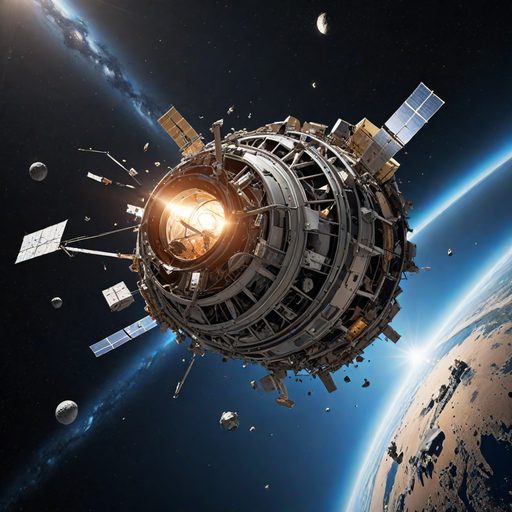
Space Junk: Can We Clean Up Our Orbital Debris?
Recommended for Exploration
The cosmos, a canvas of dreams, is being cluttered with our discarded ambitions. A silent threat lurks beyond the stars – a growing junkyard of space debris, hurtling at unimaginable speeds. Imagine a symphony of collisions, a silent orchestra playing a dangerous tune.
But why should we care about this cosmic clutter? How did it get there, and where is it hiding? More importantly, why does it pose a threat to our planet and our dreams of venturing further into the universe?
Join us on a journey to explore the hidden dangers of space junk. We’ll delve into the orbital graveyard of LEO, uncover the origins of this cosmic litter, and confront the perils it poses to our planet and space exploration.
We’ll even explore innovative solutions to clean up this cosmic mess, because, as we reach for the stars, we must also remember to tread lightly and leave a clean path for future generations.
This is not just a story of debris; it’s a tale of responsibility, innovation, and our enduring spirit of exploration. So, fasten your seatbelts and prepare for liftoff as we venture into the depths of the cosmic junkyard.
The Cosmic Junkyard – A Growing Threat
Imagine gazing up at the night sky, a canvas dotted with twinkling stars, a majestic sight that has inspired poets and dreamers for millennia. But beyond this celestial beauty, a silent threat looms – a growing junkyard of space junk, orbiting our planet at breakneck speeds.
Space junk, also known as space debris or orbital debris, is any man-made object floating aimlessly in space. It ranges from defunct satellites, the size of a bus, to tiny paint flecks and nuts and bolts, remnants of past space missions. It’s like leaving your tools scattered in the garage after a DIY project, only this garage is the vast expanse of space.
This space junk isn’t just floating idly; it’s hurtling through space at speeds exceeding 18,000 miles per hour, ten times faster than a bullet! Imagine a tiny paint chip, no bigger than a grain of sand, packing the punch of a wrecking ball. That’s the kind of danger we’re talking about.
The Debris Dance – Where and How
Low Earth Orbit (LEO), the region of space closest to Earth, has become the most crowded space junkyard. It’s like the busiest intersection in a city, with countless objects zipping around, increasing the risk of collisions.
So, how does all this junk get into space? Every rocket launch, every satellite deployment, leaves behind a trail of debris. It’s like a cosmic parade, leaving confetti in its wake. Some junk is intentional, like spent rocket stages, while others are accidental, like fragments from collisions.
Tracking this space debris is a monumental task. While we can monitor larger objects, millions of smaller pieces remain undetected, like dust bunnies under the cosmic couch. It’s estimated that there are over 170 million pieces of debris in orbit, a number that continues to grow with each passing day.
The Perils of Space Junk – A Global Threat
The consequences of space junk are far-reaching. Collisions between debris can create even more junk, a chain reaction known as the Kessler Syndrome. It’s like a domino effect, with each collision escalating the danger.
While most space junk burns up upon re-entering Earth’s atmosphere, some pieces survive, posing a risk to people and property on the ground. It’s like a cosmic lottery, with the odds of winning (or losing) increasing with each launch.
Addressing the space junk problem is crucial for the future of space exploration and the safety of our planet. It’s like cleaning up a polluted river, requiring international cooperation and innovative solutions.
Various technologies, like space nets and lasers, are being developed to capture and remove debris, but the task is as daunting as emptying the ocean with a bucket.
Epilogue: A Shared Responsibility
The space junk problem is a stark reminder that our actions have consequences, even beyond our planet. It’s a shared responsibility, requiring global collaboration and a commitment to sustainable space practices.
As we continue to explore the cosmos, let’s not forget to clean up after ourselves, ensuring that the starry sky remains a source of wonder, not worry.
Watch a video
Space debris: A problem that’s only getting bigger by Interesting Engineering (4 minutes 49 seconds)
Curious Times is a leading newspaper and website for kids. We publish daily global news aligned to your learning levels (also as per NEP 2020): Foundational, Preparatory (Primary), Middle and Senior. So, check out the News tab for this. We bring kids’ favourite Curious Times Weekly newspaper every weekend with top news, feature stories and kids’ contributions. Also, check out daily JokesPoke, Tongue Twisters, Word of the Day and Quote of the Day, kids need it all the time.
Curious Times News Program for Schools for FREE. Over 5,000 schools and teachers from all over the world have joined our programme so that students and teachers can get FREE Educative Newspaper. Here, kids can take part in world events and win prizes and certificates for free through their schools.
Moreover, schools are sharing important School News, like interviews with the principal, notices about new students, contests, and results, not just on social media but also on a news website for kids and other schools.
Thus, do not wait any further, sign-up for your school for FREE.
The following social media platforms allow you to communicate with us: WhatsApp, Instagram, Facebook, Youtube, Twitter, and LinkedIn.
0 (Please login to give a Curious Clap to your friend.)
